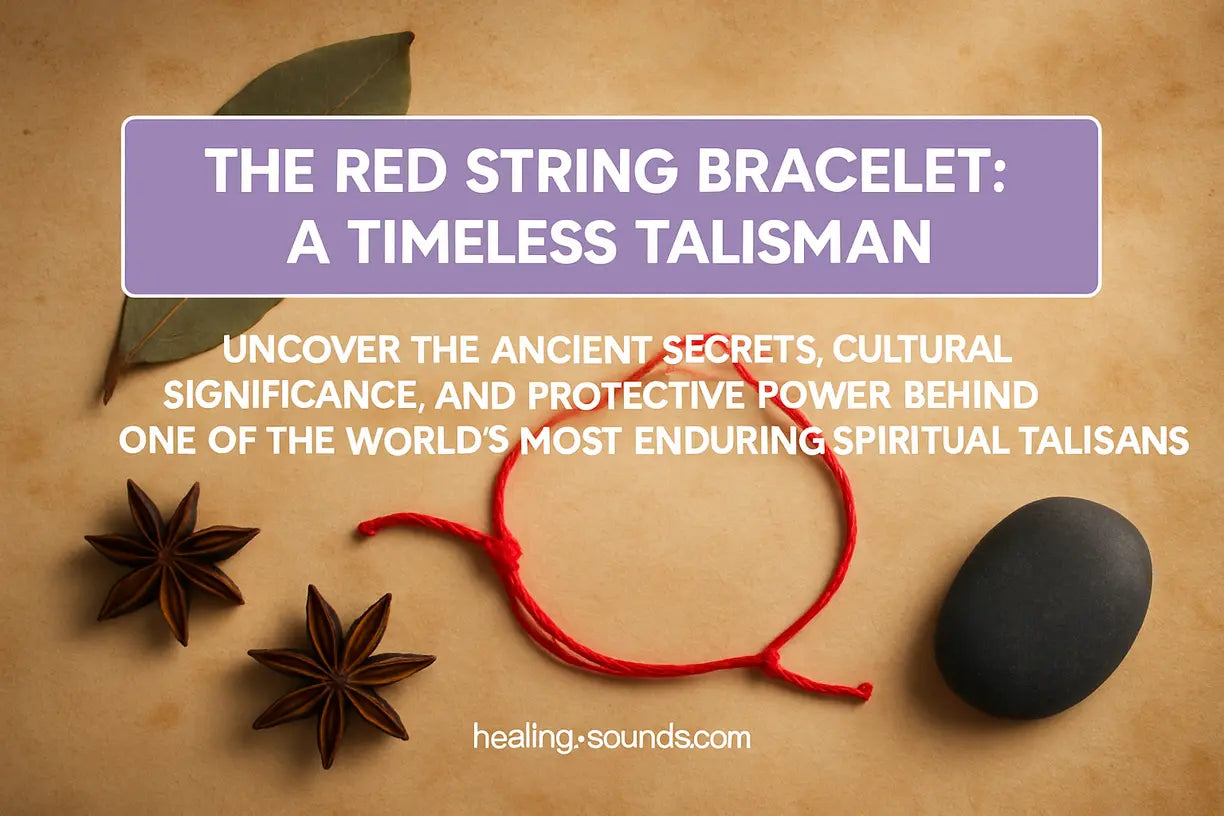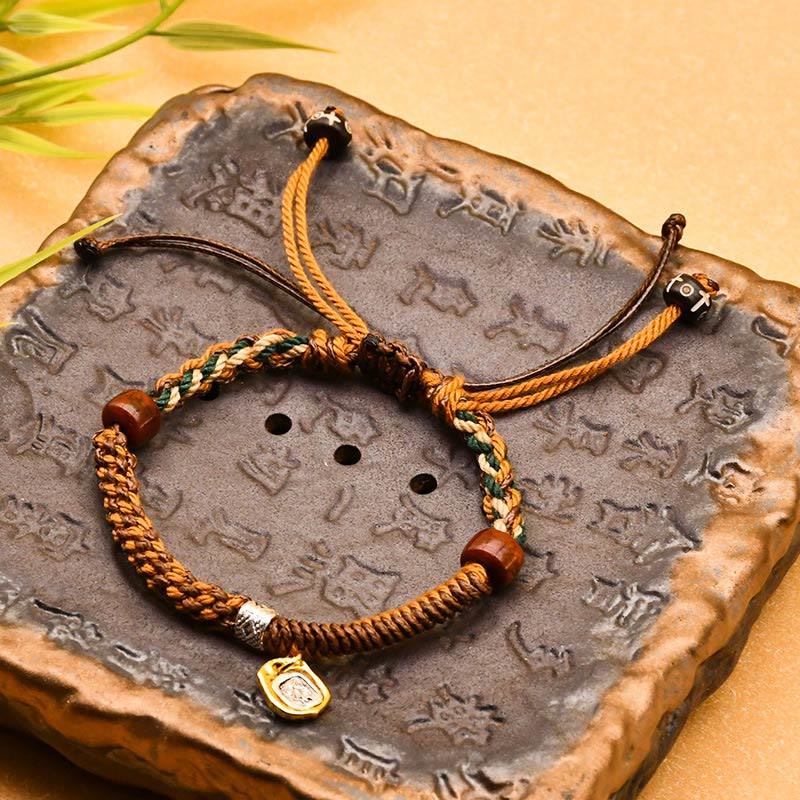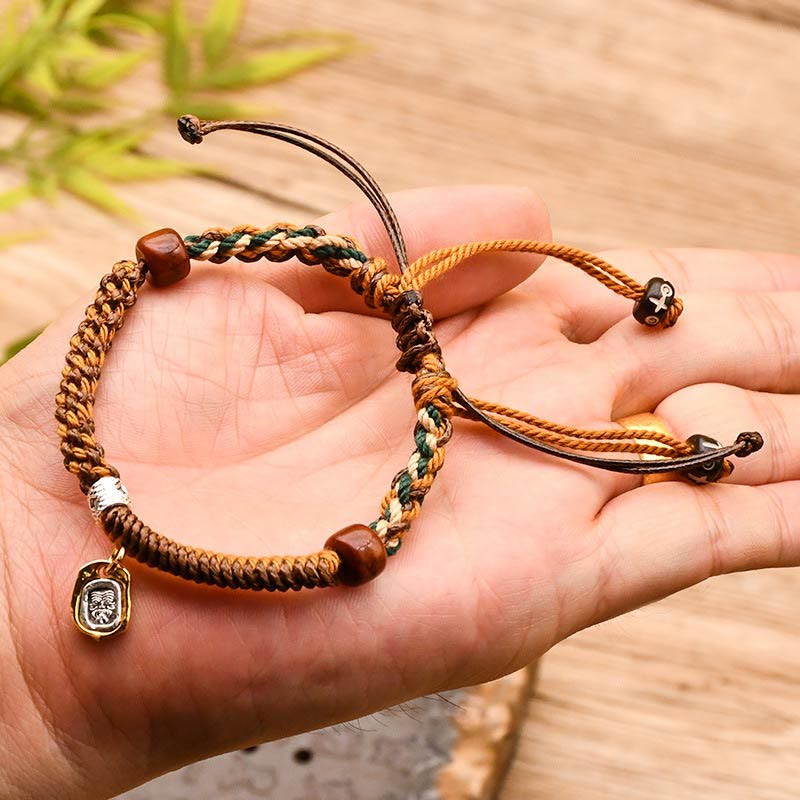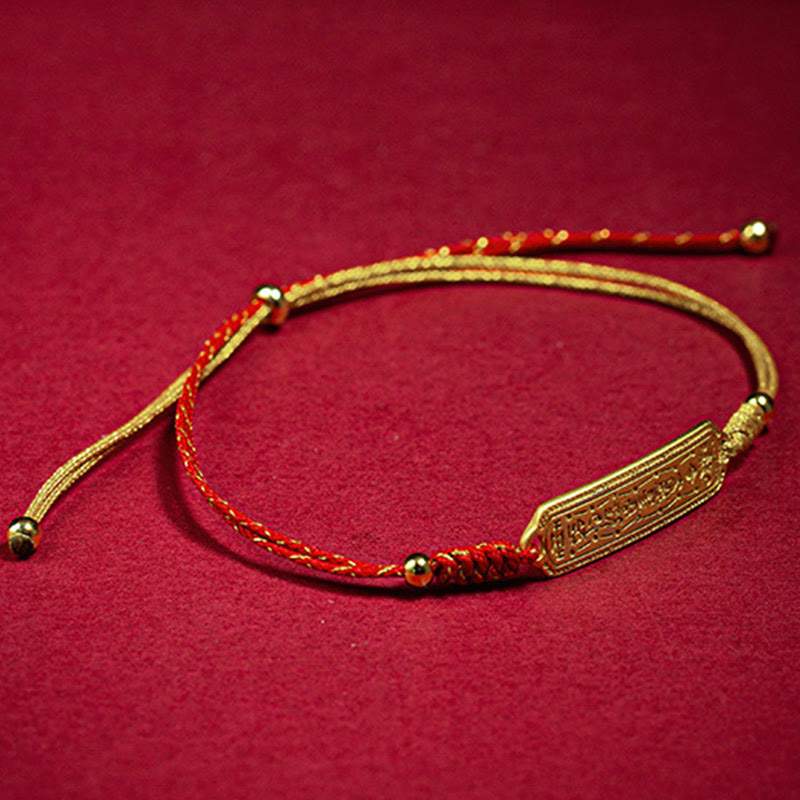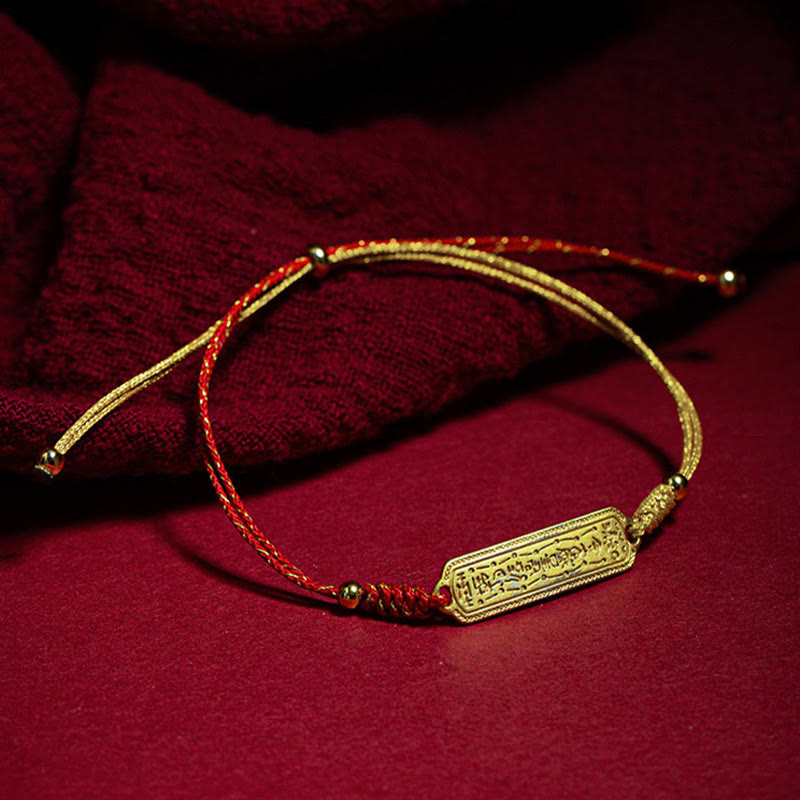Avez-vous déjà remarqué un simple et délicat cordon rouge noué au poignet d'un ami, d'une célébrité ou d'un chercheur spirituel ? Cet accessoire en apparence modeste est bien plus qu'un simple accessoire de mode. Le bracelet en cordon rouge est un puissant talisman imprégné de siècles d'histoire, de culture et d'une profonde signification spirituelle. Porté par des personnes de tous horizons, il symbolise la protection, la foi, la chance et la connexion. Si vous êtes attiré par les accessoires qui ont une âme et une histoire, vous êtes au bon endroit.
Dans ce guide complet, nous dévoilerons la riche histoire du bracelet en fil rouge, en explorant ses origines anciennes, sa signification dans diverses traditions du monde et la manière appropriée de le porter pour capter son énergie. Préparez-vous à découvrir l'histoire profonde qui se cache derrière ce symbole humble et puissant.
Quelle est la signification du bracelet à fil rouge ?
Fondamentalement, le bracelet en fil rouge symbolise la protection contre le malheur et les énergies négatives. Son but le plus connu est de conjurer le « mauvais œil » (ou ayin hara en hébreu), un regard malveillant censé causer du tort, la maladie ou la malchance. Cette croyance au pouvoir d'un regard envieux est l'une des superstitions les plus anciennes et les plus répandues au monde. Le fil rouge agit comme un bouclier, déviant cette négativité et préservant le bien-être spirituel et physique de celui qui le porte.
Au-delà de la protection, sa signification peut varier selon les cultures. C'est aussi un symbole de chance, de foi et un rappel du lien avec une puissance supérieure ou un être cher. Chaque nœud noué sur le fil peut représenter une bénédiction ou une intention particulière, ce qui en fait un outil profondément personnel et puissant pour la pleine conscience et la concentration spirituelle.

L'histoire ancienne et les origines du fil rouge
La tradition du port d'un fil rouge protecteur est ancienne et remonte à diverses cultures et textes historiques. Bien que son association avec la Kabbale soit particulièrement célèbre, des références aux fils rouges comme outils de protection et de bénédiction apparaissent dans de nombreuses lignées anciennes. Des textes bibliques aux écritures hindoues, la couleur rouge est depuis longtemps associée à la vie, à la vitalité, au courage et à la protection contre le danger.
Cette longue histoire témoigne du désir universel de sécurité et de connexion à quelque chose de plus grand que soi. Le fil rouge constitue un lien tangible avec ces croyances ancestrales, transmettant la sagesse et l'énergie protectrice des générations passées à nos vies modernes. Cette tradition a non seulement survécu, mais s'est épanouie, adaptant sa forme tout en conservant son essence spirituelle fondamentale.

Le bracelet à fil rouge à travers différentes cultures et religions
Le pouvoir du fil rouge transcende les croyances et se manifeste sous diverses formes à travers le monde. Comprendre ces différentes interprétations enrichit notre appréciation de ce symbole universel.
Kabbale et judaïsme
La tradition la plus célèbre vient peut-être de la Kabbale, une forme de mysticisme juif. Selon la tradition kabbalistique, un long fil rouge était autrefois enroulé sept fois autour du tombeau de Rachel, la matriarche biblique. Rachel est considérée comme la protectrice ultime de ses enfants, et le fil rouge est censé véhiculer sa puissante énergie protectrice. Les adeptes attachent un morceau de ce fil à leur poignet gauche , considéré comme le côté « récepteur » du corps et de l'âme, afin d'intercepter toute énergie négative avant qu'elle ne pénètre.
hindouisme
Dans l'hindouisme, le fil rouge sacré est appelé « Kalava » ou « Mauli » . Il est noué autour du poignet par un prêtre lors des pujas (cérémonies religieuses) et autres rites sacrés. Les hommes et les femmes célibataires le portent généralement au poignet droit, tandis que les femmes mariées le portent au poignet gauche. Le Kalava est un symbole de bénédiction, de connexion à Dieu et un rappel des vœux ou intentions prononcés par celui qui le porte lors de la cérémonie. Il est considéré comme un bouclier protecteur contre le mal et une source de bonne fortune.
bouddhisme
Dans le bouddhisme tibétain Vajrayana, les cordons rouges sont souvent bénis par un lama (chef spirituel) et offerts aux étudiants et aux pratiquants. Portés au poignet lors des cérémonies et des retraites, ils symbolisent la bénédiction et la protection de la lignée. Ils rappellent constamment les vœux, les enseignements et l'interdépendance de tous les êtres. Recevoir un cordon béni est un puissant moment de transmission et de connexion spirituelle .
christianisme
Bien qu'il ne s'agisse pas d'un sacrement chrétien traditionnel, certains chrétiens portent un cordon rouge comme symbole personnel de leur foi. Ils peuvent établir un parallèle avec la Bible, notamment l'histoire de Rahab dans le livre de Josué, qui utilisa un cordon écarlate pour protéger sa famille. Pour eux, cela peut servir de rappel de la rédemption, de la foi et du sang du Christ. Il s'agit d'une pratique culturelle ou personnelle plutôt que d'une pratique religieuse formelle, mais elle revêt une signification profonde pour ceux qui l'adoptent.
Les règles du port d'un bracelet à fil rouge
Pour bénéficier pleinement de ses vertus protectrices, plusieurs traditions ou « règles » sont associées au port d'un bracelet en fil rouge. Suivre ces règles permet d'honorer l'histoire et l'intention du talisman.
- Portez-le au poignet gauche : Dans la tradition kabbalistique, le côté gauche du corps est celui qui reçoit l'énergie spirituelle. Porter le bracelet au poignet gauche permet de bénéficier de ses vertus protectrices et de bloquer les influences négatives.
- Faites-le nouer par une personne qui vous aime : Le bracelet doit être noué à votre poignet par une personne sincère et soucieuse de votre bien-être. Cela lui insufflera une énergie positive et aimante dès le départ.
- Fixez-le avec sept nœuds : chacun d'eux représente une dimension spirituelle différente ou un désir que vous souhaitez manifester. Une fois les nœuds noués, vous pouvez formuler des intentions ou réciter une prière.
- Laissez-le tomber naturellement : Ne coupez pas le bracelet. On pense que lorsque le fil rouge tombe de lui-même, il a absorbé toute l'énergie négative qu'il pouvait contenir et a rempli sa fonction. C'est un signe positif que votre souhait est sur le point de se réaliser ou que vous avez été protégé.

Adopter cette tradition est une belle façon de se connecter à la sagesse ancestrale. Un bracelet simple mais élégant peut être un puissant premier pas vers ce talisman protecteur.
Bracelet de cheville porte-bonheur en perles dorées à fil rouge
$24.90
Ornez votre poignet de ce bracelet en fil rouge, doté d'une perle dorée porte-bonheur pour une touche d'élégance et de fortune.
Explorer le produitLa signification moderne : pourquoi les gens le portent-ils aujourd’hui ?
Dans notre monde moderne au rythme effréné, le bracelet en fil rouge connaît un regain de popularité. Il sert d'ancrage tangible à la pleine conscience et à la définition d'intentions. Pour beaucoup, c'est un rappel discret de rester positif, d'être bienveillant et de se sentir connecté à un chemin spirituel. C'est le symbole d'une action active pour protéger son énergie et cultiver la chance dans sa vie.
Le bracelet a transcendé ses origines purement religieuses pour devenir un symbole universel de spiritualité, de connexion et de bien-être. Qu'il soit porté pour sa signification historique, comme accessoire de mode chargé de sens ou comme rappel personnel d'une intention, le cordon rouge offre un moyen puissant de conserver un fragment de sagesse ancestrale avec soi au quotidien. Cette pratique est attestée dans de nombreuses cultures, comme l'expliquent des folkloristes d'institutions comme l' Université de Californie , témoignant de la croyance répandue en des talismans protecteurs.
[curseur de collection]
Découvrez votre talisman à fil rouge parfait
Adoptez la tradition avec ce bracelet unisexe en fil rouge, représentant la déesse Zakiram de la richesse pour la protection. En savoir plus ➔
$24.90
$35.90
Ce bracelet en fil rouge en or 14 carats offre une interprétation luxueuse d'un symbole intemporel de protection spirituelle et de bonne fortune. En savoir plus ➔
Conclusion : Un fil conducteur
Le bracelet en fil rouge est bien plus qu'un simple fil. C'est une puissante amulette tissée de fils d'histoire, de foi et d'un symbolisme profond. Du tombeau antique de Rachel aux poignets des chercheurs spirituels modernes, il constitue un bouclier constant et réconfortant contre la négativité et un symbole de bonne fortune. Il nous relie à une lignée de croyances en la protection et au pouvoir de l'intention.
Que vous cherchiez à conjurer le mauvais œil, à vous connecter à une tradition culturelle ou simplement à porter un rappel quotidien de votre force et de vos intentions, le bracelet en fil rouge est un choix précieux. Explorez notre collection pour trouver la pièce qui vous parle et entamez votre propre voyage avec ce talisman intemporel.
Questions fréquemment posées sur les bracelets à cordon rouge
Un bracelet en fil rouge est avant tout un talisman de protection contre le « mauvais œil » et les énergies négatives. Il est également largement considéré comme un symbole de chance, de foi, de connexion spirituelle et de fortune. Sa signification spécifique peut varier légèrement selon les cultures, comme la Kabbale, l'hindouisme et le bouddhisme.
Plusieurs religions et pratiques spirituelles intègrent le fil rouge. Il est surtout associé au judaïsme (notamment à la Kabbale) , mais il est également une tradition importante de l'hindouisme (où il est appelé Kalava) et du bouddhisme (notamment dans les traditions tibétaines). Certains chrétiens et personnes d'autres traditions populaires le portent également pour des raisons culturelles ou personnelles.
Les directives traditionnelles recommandent de porter le cordon rouge au poignet gauche pour recevoir son énergie protectrice. Il doit être noué par une personne qui vous aime et maintenu par sept nœuds, chacun représentant une intention spirituelle. Enfin, il ne faut jamais le couper ; laissez-le retomber naturellement une fois son effet protecteur atteint.
Oui, les chrétiens peuvent porter un bracelet en fil rouge. Bien qu'il ne s'agisse pas d'un symbole chrétien officiel ni d'un sacrement, certains le portent pour rappeler leur foi, établissant un parallèle avec le cordon écarlate de protection mentionné dans l'Ancien Testament. Pour eux, il peut symboliser la foi, la rédemption et la protection divine.
Un bracelet en fil rouge symbolise un puissant bouclier contre le malheur, l'envie et les forces négatives, souvent appelées « mauvais œil ». Il symbolise également la chance, une foi profonde et un lien avec une source spirituelle de protection et de bénédiction. C'est un symbole tangible de la volonté de celui qui le porte de vivre une vie protégée et heureuse.

